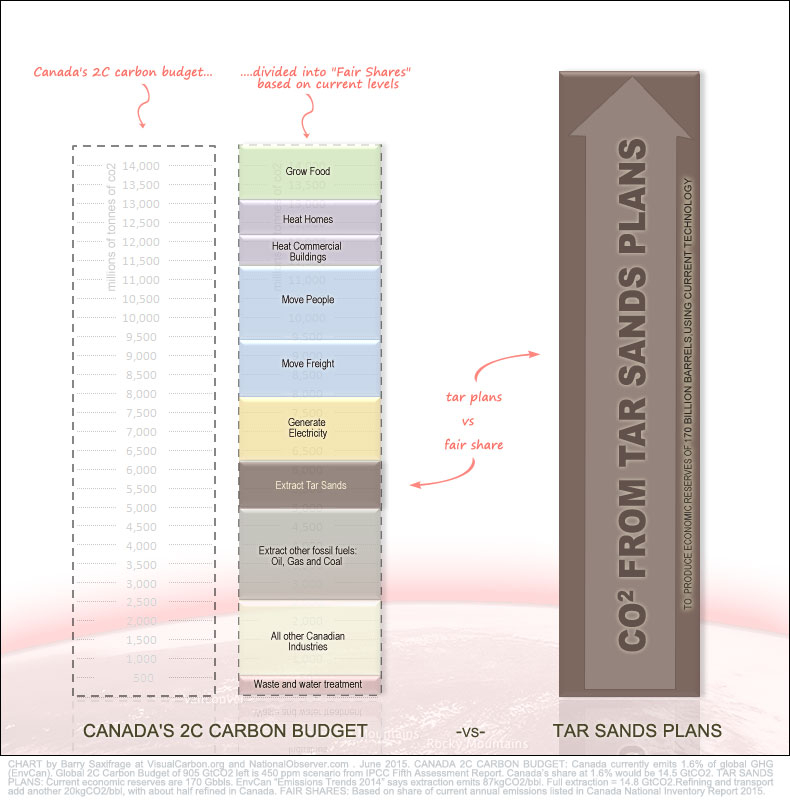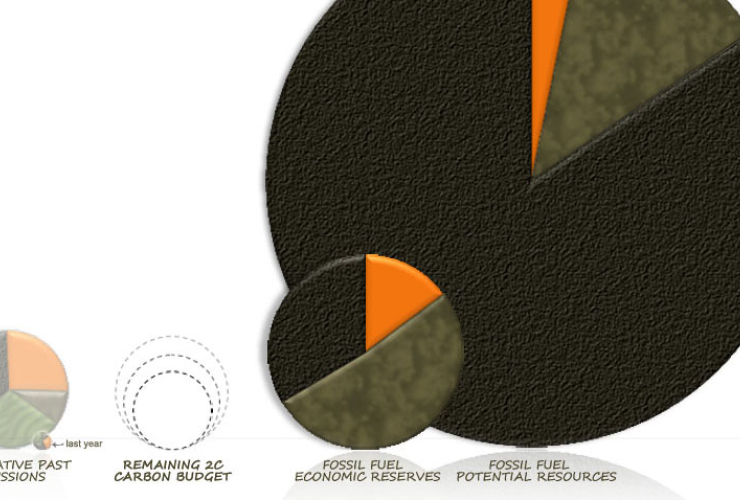A few years ago Justin Trudeau, leader of the Liberal party, declared: "There’s not a country in the world that would find 170 billion barrels of oil under the ground and leave them there."
He was referring, of course, to the Alberta tar sands. There are an estimated 170 billion barrels (170 Gbbls) that can be extracted from the tar sands, at a profit, using today's technology.
And that is exactly what the tar sands industry plans to do.
Unfortunately, just producing that tar sands oil could easily wipe out the entire remaining safe carbon budget for all of Canada.
The major governments of the world, in an effort to prevent the most damaging impacts of climate change, have pledged to keep global warming below a 2°C increase. To have a likely chance to do that, the International Panel on Climate Change (IPCC) says only around 900 GtCO2 can still be dumped into our atmosphere. That is humanity's remaining 2°C carbon budget. (See: "The climate number that changes everything").
Canada's generous share, based on our oversized current emissions, would be ~14.5 GtCO2. Even so that isn't nearly enough to accommodate the tar sands plans. Extracting the planned 170 Gbbls using today's technology would generate over 16 billion tonnes of climate pollution (~16.5 GtCO2).
And that doesn't count actually burning the oil itself.
A lot has been written about how the rapid expansion of the tar sands is driving Canada's climate failure in the short term. For example, Environment Canada data shows that tar sands expansion is already responsible for two-thirds of Canada's current climate failure.
Now, with the recent publication of high-quality carbon budgets, it is clear that tar sands expansion plans also threaten to force long-term climate failure on Canada.
Busting Canada's safe carbon budget
To appreciate the scale of the problem, take a look at my chart below.
On the left side is Canada's 2°C carbon budget. On the right side is how much climate pollution would result from tar sands plans.

Chart by Barry Saxifrage based on data from Environment Canada and the International Panel on Climate Change (IPCC).
In the notes at the bottom of this article I explain the geeky details and various assumptions behind this chart. But regardless of how these are tweaked, the glaring incompatibility between tar sands plans and Canada's fundamental climate obligations is overwhelming.
Clearly all the climate pollution planned by the tar sands industry isn't going to fit into any safe and sane climate budget for Canada.
No way.
Not by a mile.
Here are the big climate questions this little chart answers.
How much climate pollution can Canadians still safely emit?
Canada currently emits 1.6 per cent of global climate pollution. A similar 1.6 per cent share of the world's 2°C carbon budget would be ~14.5 GtCO2. In my chart this is shown as the empty bar on the left side. This is a very generous share because it assumes Canadians will be allowed to keep emitting four times the world average, per person, to the very end of the fossil fuel age.
It could be a difficult moral, political and economic fight to maintain such an oversized pollution level.
How will Canadians divvy up their limited carbon budget?
The middle bar in the chart shows one "fair share" scenario in which Canada's safe carbon budget is divided based on current emissions. For example, growing food currently emits 10 per cent of Canadian emissions, so its "fair share" in my chart is 10 per cent of our remaining carbon budget. And so on for other parts of our society. We all still need to eat, heat our homes and get around, eh?
How much can tar sands pollute?
Like all other sectors of the Canadian economy, the tar sands industry's "fair share" in this scenario is based on their current emissions. Today the tar sands industry emits nine per cent of Canada's emissions, so their "fair share" in my chart is nine per cent of our nation's safe carbon budget.
That share would be used up extracting ~15 billion barrels using current technology. This would take about a decade at current expansion rates.
How does that compare to tar sands plans?
As Mr. Trudeau noted, the plan is to extract far more than that: 170 billion barrels.
Extracting those 170 billion barrels using current technology would require Canada's entire safe carbon budget … and a whole lot more. The resulting ~16.5 GtCO2 is shown as the right hand bar in the chart.
This chart illustrates the transformative power of "carbon budgets". They allow people to easily compare climate pollution plans to what is safe for humanity.
Full climate impact is much greater
The full climate impact of tar sands plans is a whole lot worse.
Those budget-busting billions of tonnes shown in the chart are just what it takes to get the tar sands oil out of the ground. When you include the climate pollution from actually burning the tar sands product as intended, the full climate impact is seven times as large. For 170 Gbbls of tar sands oil it exceeds 100 GtCO2.
Here, then, is the climate pollution version of Mr. Trudeau's statement:
"There's not a country in the world that would find 100 billion tonnes of climate pollution in the ground and leave it there."
Our kids had better hope that isn't true.
The hunt for even more bitumen
Apparently a budget-busting 170 billion barrels of oil isn't enough.
The tar sands industry is actively working to expand their reserves. Estimates of how much more bitumen will become economically viable in the future range from two to five times current reserves. In just one example, the industry is currently trying to develop the gargantuan Grosmont formation, estimated to hold another 250 billion barrels of oil.
The search for solutions
To preserve a safe climate system, the world's best climate science shows that the vast majority of all known fossil fuels reserves must stay in the ground.
But tar sands industry and its political backers aren't planning to leave any of the tar sands reserves in the ground. As the increasingly dire climate math has started to sink in, however, their search for a climate solution has grown wider and more urgent.
My next article will explore the expanding, but so far unsuccessful, hunt for ways to reconcile tar sands expansion plans with Canada's fundamental climate obligations.
----------------------------------------------
Notes and sources
Here are the geeky details and various assumptions used in my chart and this article.
GLOBAL 2C CARBON BUDGETS
The major governments of the world, in an effort to prevent the most damaging impacts of climate change, have pledged to keep global warming below a 2oC increase. To have a "likely" chance to do that, there is only so much more carbon we can dump into our atmosphere. The world's most respected and authoritative climate report, the International Panel on Climate Change (IPCC) Fifth Assessment, lists humanity's remaining Carbon Budget at ~900 billion tonnes of CO2 (GtCO2) to have a "likely" chance of staying below 2C. This is their 450ppm scenario. For details, see: "The climate number that changed everything."
CANADA'S 2C CARBON BUDGET
Canada currently emits 1.6% of global emissions. A 1.6% share of the global carbon budget would be ~14.5 GtCO2. This is what I used in my chart.
As noted, this is a generous slice of the global budget. For one thing, Canadians emit nearly four times more climate pollution per person (21 tCO2) than the global average (6 tCO2). So it is possible that we will be pressured to cut emissions faster than much poorer nations that pollute less per person. Canadians might also decide that cutting our dangerously excessive climate pollution levels down more quickly is the morally right thing to do.
FAIR SHARES OF CANADA'S 2C CARBON BUDGET
Each sector's current annual share of national emissions was taken from Canada's 2013 official greenhouse gas inventory. For my chart, each sector's "fair share" slice of the carbon budget equaled their current annual share. For example, the tar sands industry currently emits 9% of national emissions. Its fair share in the chart is 9% of the national carbon budget.
CLIMATE POLLUTION FROM PRODUCING TAR SANDS OIL
Environment Canada Emissions Trends 2014 data shows that emissions in Canada per barrel are currently:
- 87 kgCO2 to extract each barrel of bitumen
- 25 kgCO2 to refine a barrel of oil
My math, therefore, for using current technology to extract all 170 Gbbls of tar sands economic reserves is as follows:
- 170Gbbls * .087 tCO2/bbl = ~15 GtCO2 to extract.
- 170Gbbls * .025 tCO2/bbl = ~4 GtCO2 to refine. However, I used just ~1.5 GtCO2 of this in my chart because I assumed less than half of bitumen would be refined inside Canada. The other 2.5 GtCO2 from refining tar sands oil would happen in USA or other nations.
- I did not include the emissions from transporting tar sands oil by pipeline and rail because I could not find accurate data on this.
- My total estimate: 15 + 1.5 = ~16.5 GtCO2.
The 170 Gbbls of currently economic reserves are just 9% of the bitumen in place in the tar sands. As noted, the tar sands industry is busy trying to expand their economic reserves. Not shown in my chart is the climate pollution that would result from an expansion of tar sands reserves. Here are two scenarios.
The Alberta government estimates that 17% of bitumen will become economic over time. Producing that much oil using current technology would emit ~30 GtCO2 inside Canada. That is more than double Canada's 2C Carbon Budget. The full climate impact of producing and burning that oil would be ~180 GtCO2.
Climate scientist Dr. James Hansen estimated that half of the bitumen could become economic in the future. Producing that much oil with current technology would emit ~90 GtCO2 inside Canada. The full climate impact of producing and burning that much oil would be ~520 GtCO2. That is over half of the world's remaining safe carbon budget from just one carbon deposit in one nation. In his words, that would ensure "game over" for our hopes of preserving a safe climate.








Comments